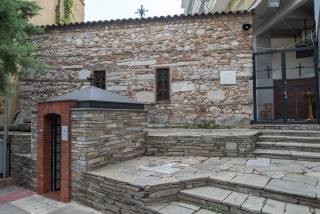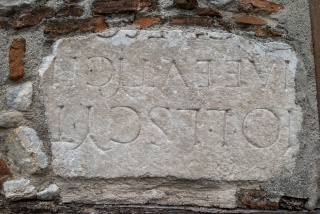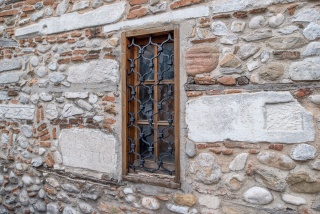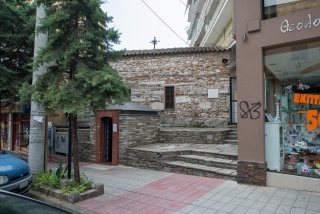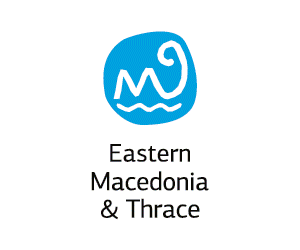Traveler's Guide
East Macedonia & Thrace
Holy Church of Taxiarches

The Holy Church of Taxiarches in Drama presents intense and priceless interest, as it shows rich historical reality from the Byzantine era. The church is located in the city center on the road Venizelos street very close to the northeastern part of the walls of the Byzantine Drama and exemplifies sculpture, architecture and painting of the Byzantine period. The temple dates back to 14th century and the architecture, sculpture and painting reveal strong marks of this period. On the monument, we distinguish four building phases: a) In the first phase there is a single-nave church with thatched roofs and staircases that lead to Byzantine walls and to entrance on the south side. b) During the period 1861-1892 the north and west walls are reconstructed, the roof becomes pitched and the temple gets a new entrance on the west side. c) The temple is surrounded by tall enclosed ambulatory with a pitched roof (which covers the ambulatory) and acquires two entrances, a northwestern and a northeastern. d) the ambulatory is demolished, the around the area is formed and the church gets its present form. The church of Taxiarches is located very close to the northeastern side of the walls of the Byzantine city, in which it is connected with stairs. It is a small and plain monument, which attracts the visitor with its masonry and the remarkable wall painting decoration. They built churches near the walls to protect them from their enemies. During the last years of the Ottoman occupation the church functioned as a temple of the Christian community of the city. In the temple there were dead people who have been taken from there. Its construction dates back in the early 14th century and, according to one version, it possibly constituted the funerary chapel, in which was buried the wife of Emperor Andronicus B, Irene Momferatiki, who is known to have died and was buried in Drama in 1320, according to the information we take from Nikiforos Grigora. Specifically, the Empress arrives from Thessaloniki to Drama. Subsequently, the relics move to Istanbul and to the placement of the Pantocrator Monastery. The daughter of Irini and Andronicus, Simonis, took care of the relics" movement from Drama to Istanbul. In this century Drama shows even for a little period that it is a town that could accommodate an empress. The demolition of the arcade in 1973 revealed the age of the building and led to the restoration of the initial form, thus enriching the city of Drama with another Byzantine monument. This is a one-room temple originally vaulted, but wooden roof nowdays. The church, nowdays has a shape of rectangular basilica with dimensions 7 x 3,45meters. The roof of the church is wooden catcher. The walls consist of stones. In the southern and eastern interior wall paintings were revealed, which depict the cycle of the Passions of Christ. The achievements of paintings that belong to the era of Palaeologus, are characterized by freedom and spontaneity. The marbled temple is remarkable. The church has undergone several reconstructions (1861-1892). However, the wall paintings remain intact and dates back in the mid 14th century. There are also stone wall paintings in the temple. Excavations in southern and eastern side of the temple pointed a part of the city wall that was connected to Taxiarhes. As part of the restoration of the temple, the temple was restored and the wall paintings were maintained. The archaeological department began to systematically deal with restoring the initial appearance of the church of Taxiarches. From the church of Hagia Sophia, there was an underground passage leading to Saint Varvara and reaching Taxiarches. On the southern side of the church, the belfry was demolished. Thereafter on the southwest side of the courtyard there was constructed a belfry and adapted to the new environment. It is however worth noticing that Leon Heaney, a professor of history and archeology in Cole de Beaux Arts in Paris, who visited Drama together with the architect H. Daudet, says he saw scattered signs in various places of the city, with Latin letters and he copied them all in detail . On the north side of the church we distinguish a Latin inscription embedded in the wall of the temple. The marbled temple of the church of Taxiarches is, like all Byzantine icon screens, a transverse bulkhead that separates the sanctuary from the main church. The supports of the iconostasis are composite. Their lower part has the form of a pessary square section, while the top pillars are formed in an octagonal cross section. The embossed decoration is limited to parapet slabs and to the front side of pessaries. The decorative theme of the parapet slabs is the leaf cross. The decoration pessaries consists of interlaced circles and diamonds that result in cross, recorded to eleven- leaf rosette. The restoration of the temple took place in the summer of 1992, by the 12th Ephorate of Byzantine Antiquities under the supervision of the architect Argyris Bakirtzis, after taking permission of the Ministry of Culture. To this work, the company Lazaridis Marble SA, also contributed, by offering marble. Fastening of the temple has been done with minerals. The initial icon screen was made of marble from the area of Philippi while the marble closure slab is from Lamia (area of old Kavala). The sculpted decoration of the marbled iconostasis of Taxiarches of Drama, presents no uniformity in either the subject or the technique. Inside the church there are preserved pieces of wall paintings that adorn the east and south walls. In the southern wall, starting from the Sanctuary, we see a representation of the Last Supper. Westwards there is a Washbasin and portions of the show of Prayer in Gethsemane. Just down the Washbasin are illustrated the Archangels Taxiarches. Under the presentation of Gethsemane, a part of the halo and the top part of a Saint"s boby that probably his whole body was depicted, are illustrated. Finally, in the pilasters of south initial entry of the temple the Saints Simeon and Alypios are represented. The spectacle of the circle of passions in combination with the two Archangels as leaders of souls leads to the conclusion that the church can be interpreted as a funerary chapel and this hypothesis is reinforced by the vaulted ossuary in the south side. The perfect execution, freedom and spontaneity are the characteristics of the paintings of Taxiarches of Drama. Thorough knowledge of the architectural depth, is something that we detect particularly in the depiction of the Last Supper. In this scene there is interpenetration of architectural structures and at the same maintenance of self-sufficiency in buildings. So, this achievements in painting belonging to the mature phase of Cave period, possibly before the mid-14th century.
Management Body: Holy Metropolis of Drama
Tel. +302521032362
Address
No information available.Contact Information
No information available.
